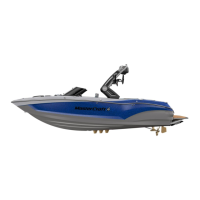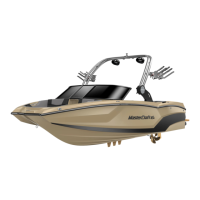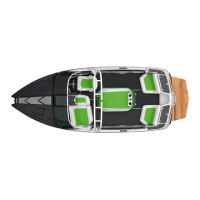2023 OWNER’S MANUAL
/
34
COMMUNICATIONS
The following applies to the Great Lakes and salt water boating:
When boating o-shore, carry communications gear such as
a marine VHF-FM and/or HF transceiver(s), appropriate to the
operating area. Cellular phone coverage is available in many
coastal areas. However, cellular phones should NOT be considered
a substitute for VHF-FM marine band radios for emergencies.
In distress situations, press the VHF transmit button and clearly
say: MAYDAY, MAYDAY, MAYDAY. Follow this with the vessel name
and/or description, the location, nature of emergency and number
of people on-board. Then release the transmit button and wait for
10 seconds. If there is no response, repeat the MAYDAY call.
Satellite EPIRBs (406 MHz) are designed to quickly and reliably
alert rescue forces, indicate an accurate distress position, and
guide rescue units to the distress scene, even when all other
communications fail.
When activated, the satellite EPIRB transmits a distress signal
with a beacon-unique identifying code. The system detects the
signal, calculates an accurate distress position, checks the unique
identifying code against the EPIRB registration database (vessel
and point of contact information supplied by the owner) and routes
the distress alert with registration information to the responsible
U.S. Coast Guard (or International) Rescue Coordination Center
(RCC).
406MHz EPIRBs with GPS (internal or attached) also provide an
immediate GPS position in the information passed to the RCC.
Geostationary satellites make detection almost immediate. If
the EPIRB does not have the ability to provide a GPS position, the
process to determine a position takes about an hour on average
and almost always less than two hours. Satellite EPIRBs also
include a homing beacon and strobe to help rescue forces quickly
locate the distress scene.
Satellite beacons have significant coverage, alerting timeliness,
position accuracy, and signaling advantages over other types of
EPIRBs (121.5 MHz). Before purchasing or using something other
than the 406 MHz EPIRB, be sure to understand the capabilities
and limitations.
Further information and a complete listing of VHF channels and
frequencies is available at: www.navcen.uscg.gov.
INSURANCE
Even if someone else is operating the boat, the owner is generally
held liable for any damages or injuries that occur. It is in the
owner’s best interest to maintain sucient personal liability and
property damage insurance on the boat in anticipation of potential
judgments. Guarding against theft is another consideration.
